Bumblebees are valuable insects that should also have a place in your garden. The 10 best plants for bumblebees can be found here.

bumblebees (bomb sp.) belong to the family of real bees (Apidae) and are therefore also closely related to our honey bee (Apis mellifera) related. The big buggers live in burrows, high tree trunks or abandoned bird nests. In Germany alone there are 36 different species - unfortunately 16 of them are now on the Red List. In the years of growing industrial agriculture, the liberal use of bee-harmful sprays and Last but not least, the loss of wild plant diversity on arable land, our heavyweight pollinators are becoming increasingly rare become. But even in many house gardens and balconies, bumblebees often do not find enough food. They need large quantities of the protein-rich pollen in particular for their larvae, and they cover their own energy needs with sugary nectar. And of course, bumblebees also need buds that are large and sturdy enough to support their weight while providing plenty of pollen and nectar. Just three to five days of starvation can mean death for the bumblebee colony. That is why we present you here in particular
bumblebee friendly plants present, which may soon find a place in your garden.With a balcony or your own garden, everyone can contribute to the preservation of our furry pollinators. Here we have compiled the most popular flowering plants for bumblebees.
contents
- 10. Real motherfucker
- 9. snapdragons
- 8. bluebell
- 7. hollyhock
- 6. globe thistle
- 5. lavender
- 4. knapweed
- 3. Poppy
- 2. Adderhead
- 1. sun bride
10. Real motherfucker
The Real Motherwort (Leonurus cardiaca) belongs to the mint family (Lamiaceae) and is also called lion's tail or heart gold. The rather inconspicuous plant that blooms in tufted, delicate pink inflorescences originally comes from Siberia and came to our cottage gardens primarily as a medicinal plant for all sorts of ailments. It prefers well-drained, sandy and light soils in full sun. In the tub, the motherwort thrives particularly well in nutrient-poor, airy herbal soil. From June to September, motherwort flowers are very attractive to many insects, including bumblebees, and provide plenty of nectar.

9. snapdragons
The snapdragons (Anthirrhinum majus) is a popular, mostly annual flowering plant that covers the entire color spectrum from white to yellow, orange, burgundy to deep violet. The bumblebee is the main pollinator of the snapdragon, because it only opens when an insect of sufficient weight settles on the lower part of the flower. Dwarf varieties up to 25 centimeters high are suitable for the balcony, while larger, woody species are suitable for the home garden. The pretty plants survive mild winters well and sprout freshly next year. The snapdragon also reproduces very well from the seeds and provides plenty of food for bumblebees from June to September.

Tip: seed mixes like that Plantura bee pasture – which is also ideal for bumblebees – contain a wide variety of bee-friendly plants. This saves you having to look for insect-friendly flowers for your garden.
8. bluebell
The various bluebells (campanula sp.) form star-shaped, white to blue-violet flowers from June to September. Depending on your needs and the garden, there are bushy varieties that are only 10 to 20 centimeters low or, like the giant bellflower (Campanula lactiflora), up to 150 centimeters high plants to choose from. The bellflower likes to be in full sun to half shade and otherwise has hardly any demands on the location. Bumblebees like to help themselves to their pollen and nectar.
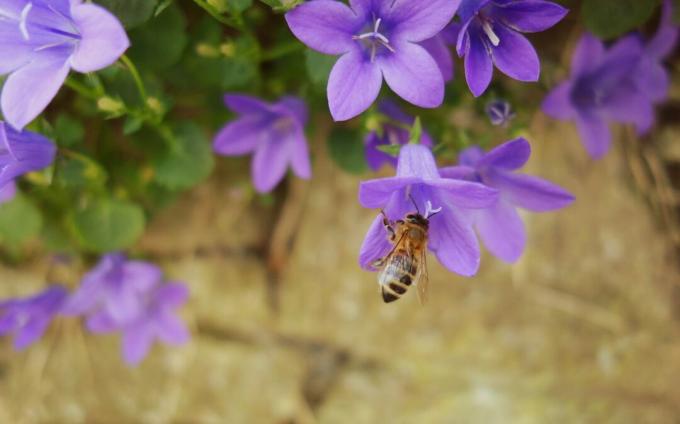
7. hollyhock
the hollyhock (Alcea rosea) delighted with their wild roses-like large flowers of all colors. Nevertheless, it belongs to the mallow family (Malvaceae) and is therefore with marshmallow (Althaea sp.) and hibiscus (Hibiscus sp.) related. It can reach a height of up to two meters and become quite sprawling. A hollyhock should not be missing in any home garden, because many wild bees and bumblebees visit the magnificent flowers from July to September. Hollyhocks are hardy and make hardly any demands on the location - they even tolerate calcareous soil.

6. globe thistle
the globe thistle (Echinops sp.) actually belongs to the thistles and reaches a height of 50 centimeters to two meters. It is perennial and forms an angular, strong stalk, at the end of which many individual flowers form a white to violet ball. During the flowering period between July and September, the pretty formations are literally swarmed by bees and butterflies. Globe thistles can be propagated by sowing or dividing the rhizome. They prefer well-drained, sandy and even rocky soils in full sun.
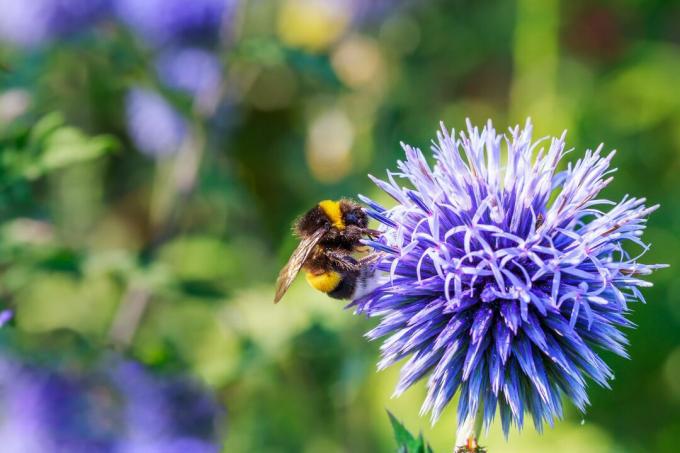
5. lavender
A classic bed design is the one that is particularly popular with bees and bumblebees lavender (Lavandula angustifolia) The fragrant, white to deep purple lipped flowers stretch towards the sun on thin, long stalks and provide nectar and pollen for hard-working pollinators from June to September. Lavender is available in a wide variety of varieties for balconies, beds and for planting under taller perennials. The growth height ranges from 20 to 80 centimeters. Lavender thrives particularly well in sunny locations on calcareous, loamy, humus-rich soil, as it requires very little water and hardly any nutrients.
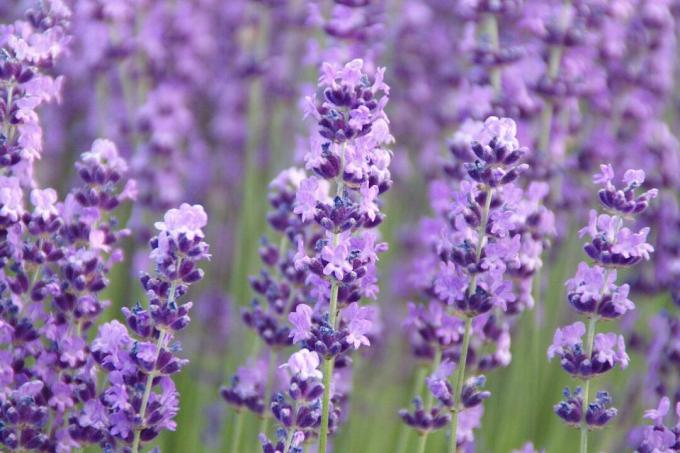
4. knapweed
the knapweed (Centaurea sp.) is a diverse group that also includes the cornflower (Centaurea cyanus) and the mountain knapweed (Centaurea montana) belong. The ray florets can be admired in white and yellow or soft pink to deep blue. There are now also burgundy versions. The delicate flowers invite bumblebees to visit them from May to August. The perennial medicinal plant reaches a height of 30 to 60 centimeters and thrives on almost any soil, but prefers sandy to loamy, sunny locations. If you regularly remove the withered flowers, the plant will keep pushing new buds.
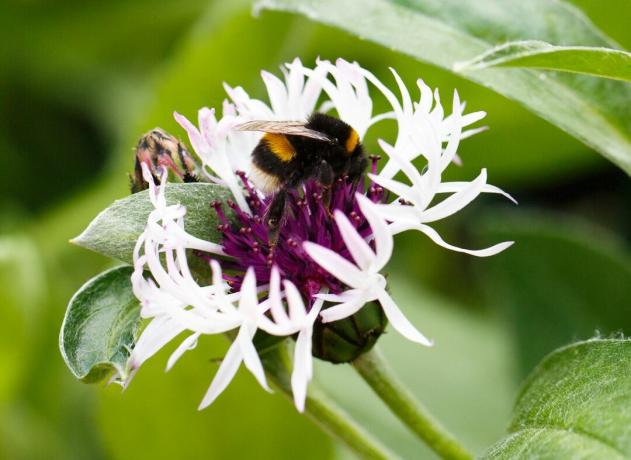
3. Poppy
The poppy (Papaver sp.) comes in many variants and colors. From bright white to deep red and violet, with semi-double or single flowers, there is never a dull moment. Depending on the species, poppies can reach a height of up to 150 centimetres, but usually stay below that. Although the plant offers little nectar from May to June, it does provide a particularly large amount of pollen for bumblebees. The flowers are also fertilized and you can harvest your own poppy seeds and sow them again - or eat them yourself with the varieties 'Gray poppy', 'Blue poppy' and 'White poppy'.

2. Adderhead
The blue-violet one Common Viper Bugloss (Echium vulgare) is a biennial or perennial plant that reaches a height of 25 to 100 centimeters. The unusual name derives from the shape of the flowers, which are reminiscent of a snake's head with an outstretched, forked tongue. It prefers sunny locations and is very well suited to sandy, stony and dry locations such as rock gardens. The plant is considered a high-quality supplier of nectar and is not only attractive to bumblebees, but also to all kinds of butterflies. The flowering period is very long, from May to October. The viper's bugloss should therefore not be missing in an insect-friendly garden.
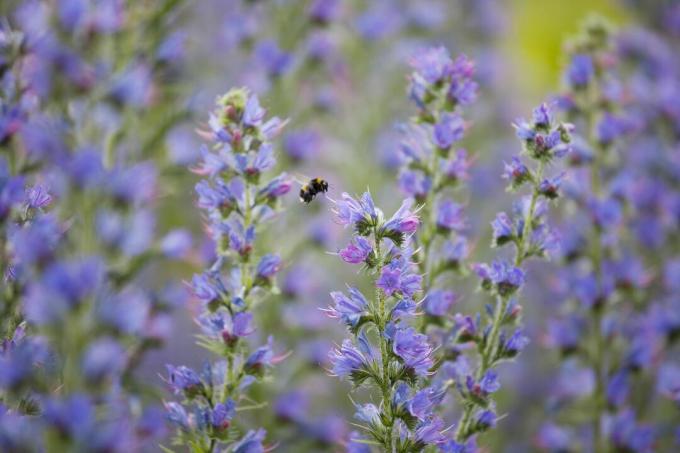
1. sun bride
The Sun Bride (Helenium sp.) impresses with its wide range of colors from blood red to lemon yellow. The perennials, which are related to sunflowers, reach a height of 50 to 170 centimeters and are inevitable to flower - with early varieties from mid-June and until late autumn. The basket flowers, popular with bees and bumblebees, were named after the sun god Helios. It is therefore not surprising that the sun bride likes to stand in full sun. As a shallow root, it needs a good water supply and fertilization in spring at the start of the season. The prairie plants also prove themselves in the tub and delight not only bumblebees, but also gardeners.

If you not only want to do something good for bumblebees, but especially for their smaller relatives, the bees, take a look at our special article on the 10 Most Bee-Friendly Plants past.
